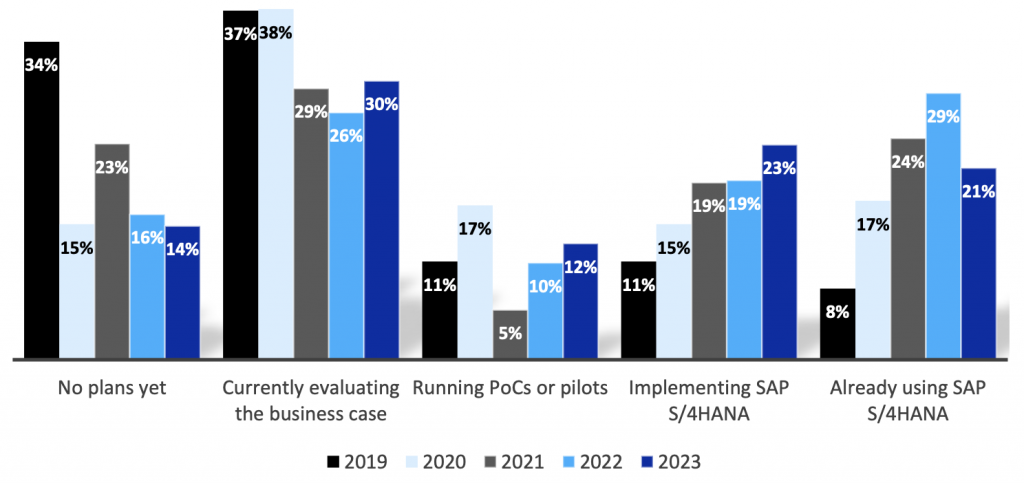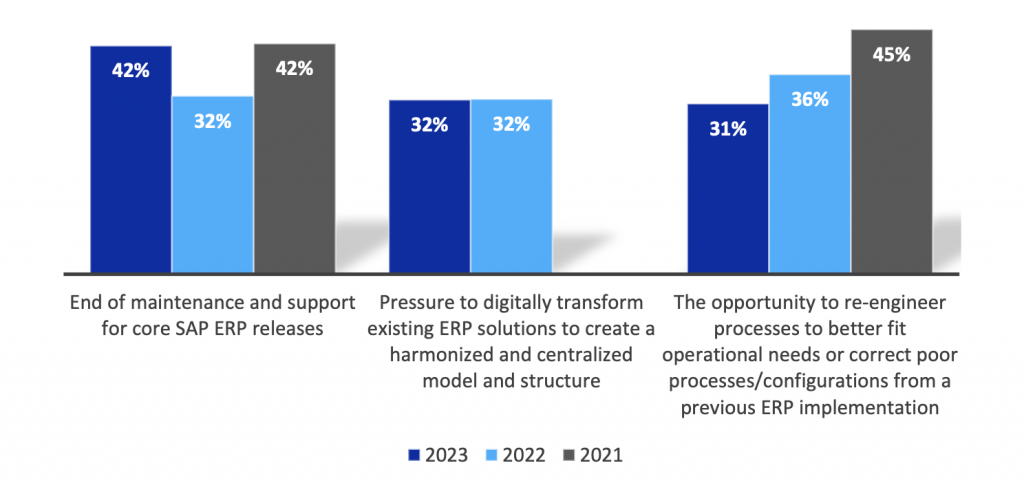SAP S/4HANA – to migrate or not to migrate? when and how?
Last updated : May 22, 2023Did you like our article?
SAP S/4HANA – to migrate or not to migrate? when and how?
To migrate or not to migrate to SAP S/4HANA
With just over two years to go before the end of support for some versions of SAP ERP in December 2025, it seems increasingly imperative to make the decision about migrating to S/4HANA and preparing for it.
Since 2020, we have been advising our clients to prepare for S/4HANA migration, for which we wrote a two-part note: S/4HANA Migration: Analysis and Preparation, Part 1 and S/4HANA Migration: Analysis and Preparation – Part 2. More recently, we emphasized the need for preparation before planning and budgeting the final project in the article How to Prepare for S/4HANA Migration.
According to 2023 surveys, only 14% of companies have no plans yet to migrate, the remaining 86%: are already using SAP S/4HANA, or are implementing, or are piloting, or are evaluating the business case.
S/4HANA Adoption Status
(SAP S/4HANA Migration, Benchmark Report, Robert Holland, March 2023)

Why migrate?
As a result of conversations with our customers, we have found that it is very important to define from the beginning what are the reasons to consider a migration to S/4HANA. In fact, there are several possible and many strategies to face the process and present it to the business or top management of the company, the main ones are:
- End of maintenance and support for major versions of SAP ERP. This means no support after 2025 or 2027, depending on the version. But it also means that the company has already been paying SAP for years for maintenance that it is not taking advantage of (42% of companies in 2023).
- Pressure to digitally transform existing SAP solutions to create a centralized, harmonized structure and model (32% of companies in 2023).
- Opportunity to redesign processes to better adapt to business needs, or to correct deficient processes and configurations of the current implementation (31% of companies in 2023).
Top Drivers
(SAP S/4HANA Migration, Benchmark Report, Robert Holland, March 2023)

Once the objectives and strategy have been clearly defined, we will be able to better orient an assessment, focusing exactly on the client’s interests and avoiding analyses that would make it unnecessarily expensive.
Why do an assessment?
After years of migrations to S/4HANA with all kinds of results, from very long, high-cost, and high-impact projects to very successful ones, we have accumulated a significant amount of experience, best practices and tools that facilitate the previous analysis, the preparation, and the migration itself.
Making an assessment has great advantages because it allows:
- To have a detailed diagnosis of the current situation regarding migration, so as to select possible strategies to evaluate in greater detail. The “how”.
- Define a roadmap of projects to prepare for migration and adapt the roadmap of other projects to make them compatible with this change.
- To have a very good estimation of project costs and deadlines. The “how much”.
- Plan the migration in the medium or long term, according to the company’s objectives, to provide the necessary budget. The “when”.
- Have an exhaustive analysis and a detailed plan to present to the company’s top management.
In subsequent installments we will go into more detail about how to address these challenges, and how Novis can help.
For more information on this and our other services, we invite you to contact us.
Feedback/discussion with author Glen Canessa, Novis Presales Director


